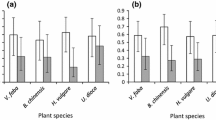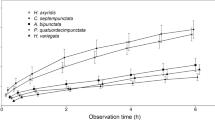Abstract
We evaluated the influence of intraguild predation among generalist insect predators on the suppression of an herbivore, the aphid Aphis gossypii, to test the appropriateness of the simple three trophic level model proposed by Hairston, Smith, and Slobodkin (1960). We manipulated components of the predator community, including three hemipteran predators and larvae of the predatory green lacewing Chrysoperla carnea, in field enclosure/exclosure experiments to address four questions: (1) Do generalist hemipteran predators feed on C. carnea? (2) Does intraguild predation (IGP) represent a substantial source of mortality for C. carnea? (3) Do predator species act in an independent, additive manner, or do significant interactions occur? (4) Can the experimental addition of some predators result in increased densities of aphids through a trophic cascade effect? Direct observations of predation in the field demonstrated that several generalist predators consume C. carnea and other carnivorous arthropods. Severely reduced survivorship of lacewing larvae in the presence of other predators showed that IGP was a major source of mortality. Decreased survival of lacewing larvae was primarily a result of predation rather than competition. IGP created significant interactions between the influences of lacewings and either Zelus renardii or Nabis predators on aphid population suppression. Despite the fact that the trophic web was too complex to delineate distinct trophic levels within the predatory arthropod community, some trophic links were sufficiently strong to produce cascades from higher-order carnivores to the level of herbivore population dynamics: experimental addition of either Z. renardii or Nabis predators generated sufficient lacewing larval mortality in one experiment to release aphid populations from regulation by lacewing predators. We conclude that intraguild predation in this system is wide-spread and has potentially important influences on the population dynamics of a key herbivore.
Similar content being viewed by others
References
Alrouechdi D, Séméria Y, New TR (1984) Ecology of natural enemies. In: Canard M, Séméria Y, New TR (eds) Biology of Chrysopidae. Dr W. Junk Publishers, The Hague, pp 187–204
Bisabri-Ershadi B, Ehler LE (1981) Natural biological control of western yellow-striped armyworm, Spodoptera praefica (Grote), in hay alfalfa in northern California. Hilgardia 49(5):1–23
Brönmark C, Klosiewski SP, Stein RA (1992) Indirect effects of predation in a freshwater, benthic food chain. Ecology 73:1662–1674
Byerly KF, Gutierrez AP, Jones RE, Luck RF (1978) A comparison of sampling methods for some arthropod populations in cotton. Hilgardia 46(8):257–282
Canard M, Séméria Y, New TR (eds) (1984) Biology of Chrysopidae. Dr W. Junk Publishers, The Hague
Carpenter SR, Kitchell JF (1988) Consumer control of lake productivity. Bioscience 38:764–769
Carpenter SR, Kitchell JF, Hodgson JR (1985) Cascading trophic interactions and lake productivity. Bioscience 35:634–639
Croft BA, MacRae IV (1992a) Biological control of apple mites by mixed populations of Metaseiulus occidentalis (Nesbitt) and Typhlodromus pyri Scheuten (Acari: Phytoseiidae). Environ Entomol 21:202–209
Croft BA, MacRae IV (1992b) Persistence of Typhlodromus pyri and Metaseiulus occidentalis (Acari: Phytoseiidae) on apple after inoculative release and competition with Zetzellia mali (Acari: Stigmaeidae). Environ Entomol 21:1168–1177
Diehl S (1992) Fish predation and benthic community structure: the role of omnivory and habitat complexity. Ecology 73:1646–1661
Ehler LE (1977) Natural enemies of cabbage looper on cotton in the San Joaquin Valley. Hilgardia 45(3):73–106
Ehler LE, Miller JC (1978) Biological control in temporary agroecosystems. Entomophaga 23:207–212
Fagan WF, Hurd LE (1991) Direct and indirect effects of generalist predators on a terrestrial arthropod community. Am Midl Nat 126:380–384
Fretwell SD (1977) The regulation of plant communities by the food chains exploiting them. Perspectives Biol Med 20:169–185
Fretwell SD (1987) Food chain dynamics: the central theory of ecology? Oikos 50:291–301
Hairston NG, Smith FE, Slobodkin LB (1960) Community structure, population control, and competition. Amer Nat 94:421–425
Head RB (1992) Cotton insect losses 1991. Proc Beltwide Cotton Conf 621–625
Hurd LE, Eisenberg RM (1984) Experimental density manipulations of the predator Tenodera sinensis (Orthoptera: Mantidae) in an old-field community. II. The influence of mantids on arthropod community structure. J Anim Ecol 53:955–967
Hurd LE, Eisenberg RM (1990) Arthropod community responses to manipulation of a bitrophic predator guild. Ecology 71:2107–2114
McPeek MA (1990) Behavioral differences between Enallagma species (Odonata) influencing differential vulnerability to predators. Ecology 71:1714–1726
Menge BA, Sutherland JP (1976) Species diversity gradients: synthesis of the roles of predation, competition, and temporal heterogeneity. Am Nat 110:351–369
Menge BA, Sutherland JP (1987) Community regulation: variation in disturbance, competition, and predation in relation to environmental stress and recruitment. Amer Nat 130:730–757
Pacala S, Roughgarden J (1984) Control of arthropod abundance by Anolis lizards on St. Eustatius (Neth. Antilles). Oecologia 64:160–162
Polis GA (1991) Complex trophic interactions in deserts: an empirical critique of food-web theory. Am Nat 138:123–155
Polis GA, Holt RD (1992) Intraguild predation: the dynamics of complex trophic interactions. Trends Ecol Evol 7:151–154
Polis GA, McCormick SJ (1987) Intraguild predation and competition among desert scorpions. Ecology 68:332–343
Polis GA, Myers CA, Holt RD (1989) The ecology and evolution of intraguild predation: potential competitors that eat each other. Annu Rev Ecol Syst 20:297–330
Power ME (1990) Effects of fish in river food webs. Science 250:811–814
Power ME (1992a) Top-down and bottom-up forces in food webs: do plants have primacy? Ecology 73:733–746
Power ME (1992b) Habitat heterogeneity and the functional significance of fish in river food webs. Ecology 73:1675–1688
Power ME, Marks JC, Parker MS (1992) Variation in the vulnerability of prey to different predators: community-level consequences. Ecology 73:2218–2223
Salas-Aguilar J, Ehler LE (1977) Feeding habits of Orius tristicolor. Ann Entomol Soc Am 70:60–62
Sih A, Crowley P, McPeek M, Petranka J, Strohmeier K (1985) Predation, competition, and prey communities: a review of field experiments. Annu Rev Ecol Syst 16:269–311
Spiller DA (1986) Interspecific between spiders and its relevance to biological control by general predators. Environ Entomol 15:177–181
Spiller DA, Schoener TW (1988) An experimental study of the effect of lizards on webspider communities. Ecol Monogr 58:57–77
Spiller DA, Schoener TW (1990) A terrestrial field experiment showing the impact of eliminating top predators on foliage damage. Nature 347:469–472
Spiller DA, Schoener TW (in press) Effects of top and intermediate predators in a terrestrial food web. Ecology.
Sterling WL, El-Zik KM, Wilson LT (1989) Biological control of pest populations. In: Frisbie RE, El-Zik KM, Wilson LT (eds) Integrated Pest Management Systems and Cotton Production. John Wiley & Sons, New York, pp 155–189
Strong DR (1992) Are trophic cascades all wet? Differentiation and donor-control in speciose ecosystems. Ecology 73:747–754
Trichilo PJ, Leigh TF (1986) Predation on spider mite eggs by the western flower thrips, Frankliniella occidentalis (Thysanoptera: Thripidae), an opportunist in a cotton agroecosystem. Environ Entomol 15:821–825
University of California (1984) Integrated Pest Management for Cotton in the Western Region of the United States. Univ Calif Div Agric Natural Resources Publ 3305
van den Bosch R, Hagen KS (1966) Predaceous and parasitic arthropods in California cotton fields. Calif Agric Expt Stat Bull 820
Warren PH, Lawton JH (1987) Invertebrate predator-prey body size relationships: an explanation for upper triangular food webs and patterns in food web structure? Oecologia 74:231–235
Whitcomb WH, Bell K (1964) Predaceous insects, spiders, and mites of Arkansas cotton fields. Univ Arkansas Agric Expt Sta Bull 690
Wilhoit LR, Rosenheim, JA (1993) The yellow dwarf form of the cotton aphid, Aphis gossypii. Proc Beltwide Cotton Conf 969–972
Wilson LT, Gutierrez AP (1980) Within-plant distribution of predators on cotton: comments on sampling and predator efficiencies. Hilgardia 48(2):3–11
Wise DH (1993) Spiders in Ecological Webs. Cambridge University Press, Cambridge, U.K.
Wissinger SA (1992) Niche overlap and the potential for competition and intraguild predation between size-structured populations. Ecology 73:1431–1444
Zheng Y, Hagen KS, Daane KM, Mittler TE (1993) Influence of larval dietary supply on the food consumption, food utilization efficiency, growth and development of the lacewing Chrysoperla carnea. Entomol Exp Appl 67:1–7
Author information
Authors and Affiliations
Rights and permissions
About this article
Cite this article
Rosenheim, J.A., Wilhoit, L.R. & Armer, C.A. Influence of intraguild predation among generalist insect predators on the suppression of an herbivore population. Oecologia 96, 439–449 (1993). https://doi.org/10.1007/BF00317517
Received:
Accepted:
Issue Date:
DOI: https://doi.org/10.1007/BF00317517




